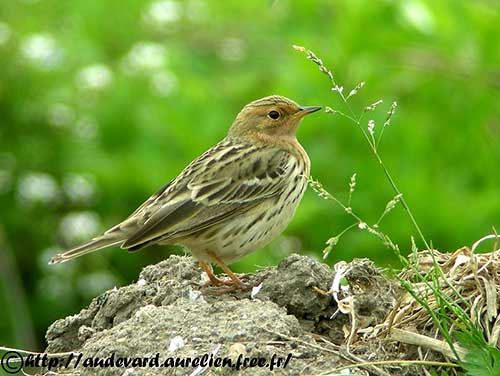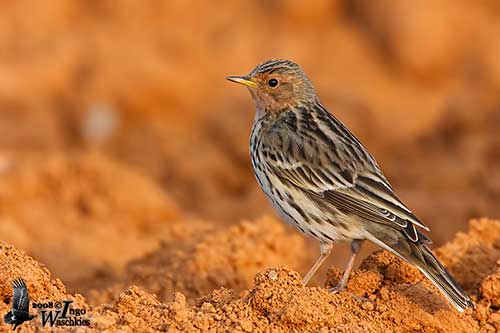
Fr: Pipit à gorge rousse
Ang: Red-throated Pipit
All: Rotkehlpieper
Esp: Bisbita Gorgirrojo
Ita: Pispola golarossa
Nd: Lappiplerke
Sd: rödstrupig piplärka
Photographers:
Aurélien Audevard
OUESSANT DIGISCOPING
Otto Plantema
Trips around the world
Ingo Waschkies
Bird Photography
Text by Nicole Bouglouan
Sources:
HANDBOOK OF THE BIRDS OF THE WORLD Vol 9 - by Josep del Hoyo - Andrew Elliot - David Christie - Lynx Edicions - ISBN: 8487334695
THE HANDBOOK OF BIRD IDENTIFICATION FOR EUROPE AND THE WESTERN PALEARCTIC by Mark Beaman, Steve Madge - C. Helm - ISBN: 0713639601
A Field Guide to the Birds of South-East Asia by Craig Robson. New Holland Publishers. ISBN: 9781780090498
BIRDS OF THE MIDDLE EAST by R.F. Porter, S. Christensen, P Schiermacker-Ansen C.Helm - ISBN: 0713670169
Animal Diversity Web (University of Michigan Museum of Zoology)
Neotropical Birds – Cornell Lab of Ornithology
What Bird-The ultimate Bird Guide (Mitchell Waite)
Wikipedia, the free encyclopaedia
Red-throated Pipit
Anthus cervinus
Passeriformes Order – Motacillidae Family
INTRODUCTION:
The Red-throated Pipit is a long-distance migrant breeding in the far north of Europe and Asia, with a small breeding population in W Alaska. It moves south to winter in Africa, SE Asia and W coast of United States.
It frequents the tundra in summer, whereas it favours the cultivated areas on passage. It winters in muddy, wet areas and may occur at high elevations in Africa. It is primarily an insect-eater, but other invertebrates and seeds are also taken.
The Red-throated Pipit is monogamous and the male performs a beautiful song flight. The nest is on the ground and the chicks are tended by both adults.
The population is currently stable and this species is not globally threatened.

DESCRIPTION OF THE BIRD:
Biometrics:
Length: 14-15 cm
Weight: 16-29 g
The Red-throated Pipit adult male in breeding plumage has rusty-red face, supercilium and upper breast, and brownish lores and ear-coverts, making it different from other pipit species. The upperparts are pale brown with broad, dark streaking. A double V or “braces” is formed by the pale edges of mantle’s feathers. The tail is blackish-brown with buff fringes to central pair of rectrices. On the upperwing, the coverts are tipped white and the flight feathers have buff edges.
On the underparts, chin, throat and upper breast are deep buffy-pink. The upper breast may show sparse, narrow, blackish streaks. Rest of underparts is mostly creamy-white with conspicuous black streaks on lower breast and flanks. On the underwing, coverts and axillaries are greyish-white.
The bill is blackish with yellowish base of lower mandible. The eyes are dark brown. Legs and feet are pinkish-brown.
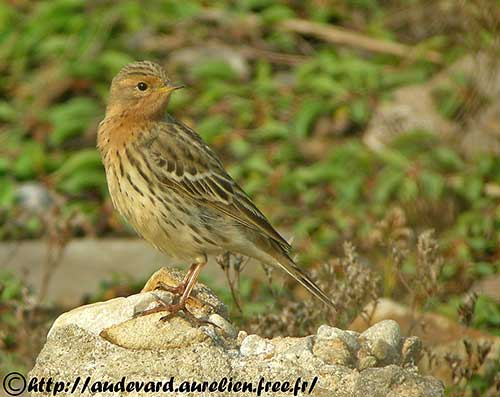
In non-breeding plumage, the male has duller head pattern with buffish supercilium and chin to breast, sometimes with pink wash. The breast is heavily streaked and we can see a blackish malar stripe.
The Red-throated Pipit adult female in breeding plumage has duller head and breast, mostly pinkish and less extensive. The upper breast is buff and heavily streaked.
In non-breeding plumage, she resembles male but she lacks the pink tinge on supercilium and breast.
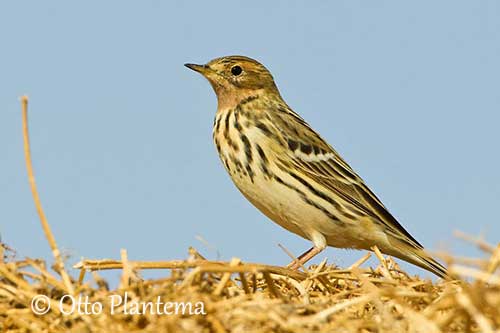
The immature has conspicuous black malar stripe. The underparts are buffy-white and boldly streaked black. The supercilium is buffy-white.
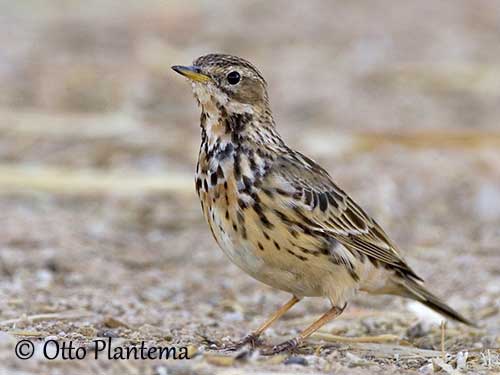
RANGE:
The Red-throated Pipit breeds N of Arctic Circle from N Fennoscandia E to NE Russia (Chukotsk Peninsula S to Kamchatka) and W Alaska. It winters in Africa, mainly sub-Saharan Africa, SE Asia, and west coast of United States.
HABITAT:
The Red-throated Pipit breeds in swampy meadows and boggy tundra, generally in areas of wet tundra with low willow trees and birch scrub. In Alaska, it breeds on tundra, mainly in dry rocky areas close to hummocky sedge meadows.
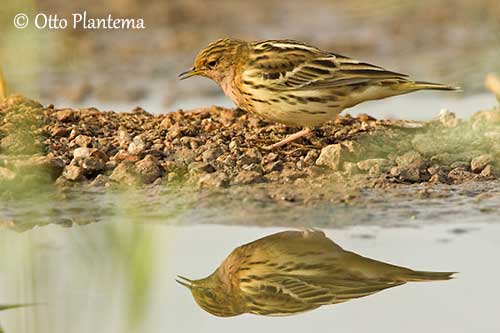
CALLS AND SONGS: SOUNDS BY XENO-CANTO
The Red-throated Pipit gives a thin, plaintive, high-pitched “seeeee” in flight, fading towards the end. A low “chup” is more rarely heard. The alarm call during the breeding season is a dry “tsweeep”.
The ringing song includes sharp, drawn-out notes and dry buzzy sounds, described as a series of rising notes followed by a bubbling trill. The song is given during the aerial displays. A more subdued form is given from the ground.
BEHAVIOUR IN THE WILD:
The Red-throated Pipit feeds primarily on insects such as midges, crane flies, mosquitoes, beetles, caterpillars, small bees, moths and other species. It also takes spiders, centipedes, small snails, worms and plant material such as seeds of grasses and other plant species.
The Red-throated Pipit forages on the ground, walking and picking food items, also from the low vegetation. The larger prey may be pounded on the ground before to be swallowed.
Like other pipits, it adopts a horizontal posture while walking quickly. It often wags its tail. Outside breeding season, it forages in small, loose flocks.
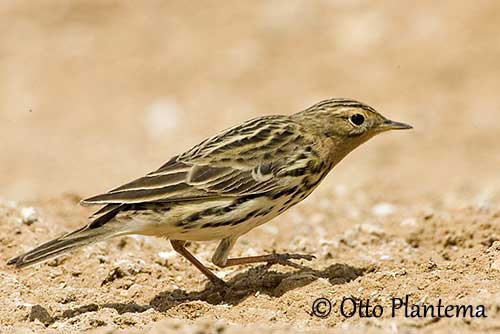
During the breeding season, the male performs the typical aerial displays of pipit species. It rises obliquely up to 20 metres on fluttering wings, before to perform a parachuting descent with wings uplifted and while singing loudly. It may also flutter on horizontal course for up to 50 metres, before dropping to the ground. These flights are accompanied by songs.
Another display shows the male in front of the female with quivering wings and tail, raising the bill to display the red throat.
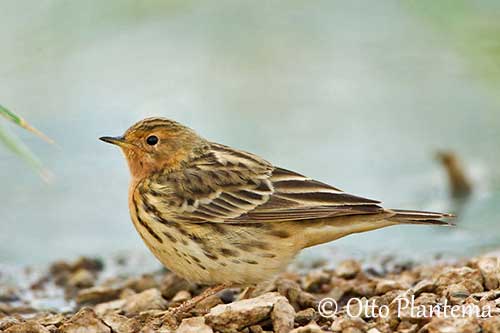
The Red-throated Pipit is a long-distance migrant, moving S to sub-Saharan Africa and SE Asia. They leave the breeding grounds from mid-August and reach Kenya from late October. The return migration starts in March/April in Kenya and Middle-East, and during the first half of May in C Europe. They reach their breeding areas from late May.
In flight, the Red-throated Pipit alternates several rapid wingbeats with wings pulled to sides, involving undulating flight pattern.
REPRODUCTION OF THIS SPECIES:
The egg-laying occurs early June/mid-June or July in northern range, and from late May in south.
The female builds the nest on the ground, often against a hummock, or sheltered by rock or low vegetation. Usually, the male scrapes a shallow hollow in moss and then, the female builds the cup-shaped nest with leaves and stems, above a base made with moss and dead leaves. It is lined with softer grasses, and sometimes with animal hair and bird feathers.
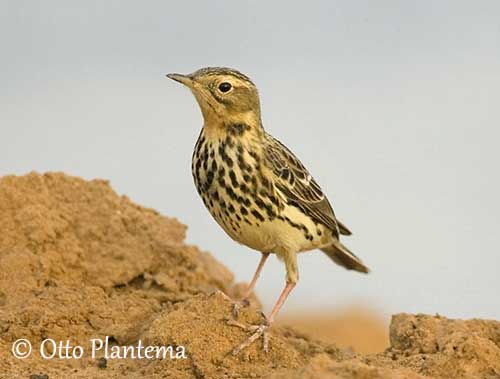
The female lays 3-7 or 5-6 pale grey to buff eggs with fine brown/grey spots. She incubates alone during 11-13 days, fed by the male during this period. The chicks are fed by both parents. They leave the nest 11-15 days after hatching.
PROTECTION / THREATS / STATUS:
The Red-throated Pipit is common to very common throughout its range.
The population is estimated to number 12,500,000/180,000,000 individuals after a very preliminary estimate. This population seems to be stable.
The Red-throated Pipit is currently evaluated as Least Concern.
